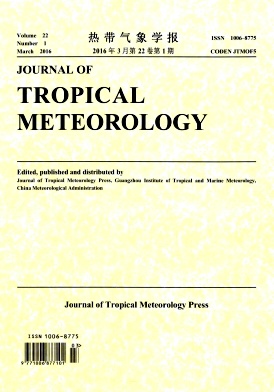|
[1]
|
CHAN C, TANG J, LI Y, et al. Mixing ratios and sources of halocarbons in urban, semiurban and rural sites of the Pearl River Delta, South China [J]. Atmos Environ, 2006, 40: 7331-7345, doi:10.1016/j.atmosenv.2006.06.041. |
|
[2]
|
WU Dui, BI Xue-yan, DENG Xue-jiao, et al. Effect of atmospheric haze on the deterioration of visibility over the Pearl River Delta [J]. Acta Meteorol Sinica, 2007, 21: 215-223. |
|
[3]
|
CHEN Xun-lai, FAN Shao-jia, LI Jiang-nan, et al. Typical weather characteristics associated with air pollution in Hong Kong area [J]. J Trop Meteorol , 2008, 14: 101-104. |
|
[4]
|
FENG Y, WANG A, WU D, et al. The influence of tropical cyclone Melor on PM10 concentrations during an aerosol episode over the Pearl River Delta region of China: numerical modeling versus observational analysis [J]. Atmos Environ, 2007, 41: 4 349-4 365, doi:10.1016/j.atmosenv.2007.01.055. |
|
[5]
|
WU D, TIE X X, LI C C, et al. An extremely low visibility event over the Guangzhou region: a case study [J]. Atmos Environ, 2005, 39: 6 568-6 577, doi:10.1016/j.atmosenv.2005.07.061. |
|
[6]
|
XIA Dong, WU Zhi-quan, MO Wei-qiang, et al. Analysis of a Haze Process Caused by Peripheral Subsidence of Tropical Cyclones over the Pearl River Delta Region [J]. Meteorol Mon, 2013, 39(6): 759-767, doi: 10.7519/j.issn.1000-0526.2013.06.012. |
|
[7]
|
DING A J, WANG T, ZHAO M, et al. Simulation of sea-land breezes and a discussion of their implications on the transport of air pollution during a multiday ozone episode in the Pearl River Delta of China[J]. Atmos Environ, 2004, 38: 6 737-6 750, doi:10.1016/j.atmosenv.2004.09.017. |
|
[8]
|
FAN Shao-jia, DONG Juan, GUO Lu-lu, et al. Analysis of the impact of urban growth on the tempreture field in Guangzhou [J]. J Trop Meteorol, 2006, 12: 24-28. |
|
[9]
|
DING A J, WANG T, XUE L K, et al. Transport of north China air pollution by midlatitude cyclones: case study of aircraft measurements in summer 2007 [J]. J Geophys Res, 2009, 114: D08304, doi:10.1029/2008jd011023. |
|
[10]
|
XIAO F, BRAJER V, MEAD R W. Blowing in the wind: the impact of China’s Pearl River Delta on Hong Kong’s air quality [J]. Sci Total Environ, 2006, 367: 96-111, doi:10.1016/j.scitotenv.2006.01.010. |
|
[11]
|
CARRERAS H A, PIGNATA M L. Comparison among air pollutants, meteorological conditions and some chemical parameters in the transplanted lichen Usnea amblyoclada [J]. Environ Pollut, 2001, 111: 45-52. |
|
[12]
|
COGLIANI E. Air pollution forecast in cities by an air pollution index highly correlated with meteorological variables [J]. Atmos Environ, 2001, 35: 2 871-2 877. |
|
[13]
|
KHEDAIRIA S, KHADIR M T. Impact of clustered meteorological parameters on air pollutants concentrations in the region of Annaba, Algeria [J]. Atmos Res, 2012, 113: 89-101, doi:10.1016/j.atmosres.2012.05.002. |
|
[14]
|
TAN J H, DUAN J C, HE K B, et al. Chemical characteristics of PM2.5 during a typical haze episode in Guangzhou[J]. J Environ Sci, 2009, 21: 774-781, doi: 10.1016/s1001-0742(08)62340-2. |
|
[15]
|
MENUT, L, COLL I, CAUTENET S. Impact of meteorological data resolution on the forecasted ozone concentrations during the ESCOMPTE IOP2a and IOP2b [J]. Atmos Res, 2005, 74: 139-159, doi:10.1016/j.atmosres.2004.04.008. |
|
[16]
|
GRINN-GOFRON A, STRZELCZAK A, WOLSKI T. The relationships between air pollutants, meteorological parameters and concentration of airborne fungal spores [J]. Environ Pollut, 2011, 159: 602-608, doi:10.1016/j.envpol.2010.10.002. |
|
[17]
|
KOLEV I, SAVOV P, KAPRIELOV B, et al. Lidar observation of the nocturnal boundary layer formation over Sofia, Bulgaria[J]. Atmos Environ, 2000, 34: 3 223-3 235. |
|
[18]
|
DAVIES F, MIDDLETON D R, BOZIER K E. Urban air pollution modeling and measurements of boundary layer height [J]. Atmos Environ, 2007, 41: 4 040-4 049, doi:10.1016/j.atmosenv.2007.01.015. |
|
[19]
|
GAO Y, LIU X, ZHAO C, et al. Emission controls versus meteorological conditions in determining aerosol concentrations in Beijing during the 2008 Olympic Games [J]. Atmos Chem Phys, 2011, 11: 12437-12451, doi:10.5194/acp-11-12437-2011. |
|
[20]
|
SCHLEICHER N, NORRA S, CHEN Y, et al. Efficiency of mitigation measures to reduce particulate air pollution-a case study during the Olympic Summer Games 2008 in Beijing, China [J]. Sci Total Environ, 2012, 427-428; 146-158, doi:10.1016/j.scitotenv.2012.04.004. |
|
[21]
|
ZHANG J P, ZHU T, ZHANG Q H, et al. The impact of circulation patterns on regional transport pathways and air quality over Beijing and its surroundings [J]. Atmos Chem Phys, 2012, 12: 5031-5053, doi:10.5194/acp-12-5031- 2012. |
|
[22]
|
NEFF W, HELMIG D, GRACHEV A, et al. A study of boundary layer behavior associated with high NO concentrations at the South Pole using a minisodar, tethered balloon, and sonic anemometer[J]. Atmos Environ, 2008, 42: 2 762-2 779, doi:10.1016/j.atmosenv.2007.01.033. |
|
[23]
|
HANNA S R, MACDONALD C P, LILLY M, et al. Analysis of three years of boundary layer observations over the Gulf of Mexico and its shores, Estuar [J]. Coast Shelf S, 2006, 70: 541-550, doi:10.1016/j.ecss.2006.06.005. |
|
[24]
|
EMEIS S, MüNKEL C, VOGT S, et al. Atmospheric boundary-layer structure from simultaneous SODAR, RASS, and ceilometer measurements [J]. Atmos Environ, 2004, 38: 273-286, doi:10.1016/j.atmosenv.2003.09.054. |
|
[25]
|
ALAPPATTU D P, KUNHIKRISHNAN P K. Observations of the thermodynamic structure of marine atmospheric boundary layer over Bay of Bengal, Northern Indian Ocean and Arabian Sea during premonsoon period [J]. J Atmos Sol-Terr Phy, 2010, 72: 1 318-1 326, doi:10.1016/j.jastp.2010.07.011. |
|
[26]
|
QIU Xiao-yuan, FAN Shao-jia. Progress of Sea Land Breeze Study and the Characteristics of Sea Land Breeze in Three Coastal Areas in China [J]. Meteorol Mon, 2013, 39(2), 186-193, doi: 10.7519/j.issn.1000-0526.2013.02.007. |
|
[27]
|
PORSON A, STEYN D, SCHAYES G. Formulation of an index for sea breezes in opposing winds [J]. J Climate Appl Meteor, 2007, 46: 1 257-1 263. |
|
[28]
|
PRTENJAK M. Main characteristics of sea/land breezes along the eastern coast of the Northern Adriatic [J]. Geofizika, 2003, 20: 75-92. |

















 粤公网安备 4401069904700002号
粤公网安备 4401069904700002号
 DownLoad:
DownLoad: